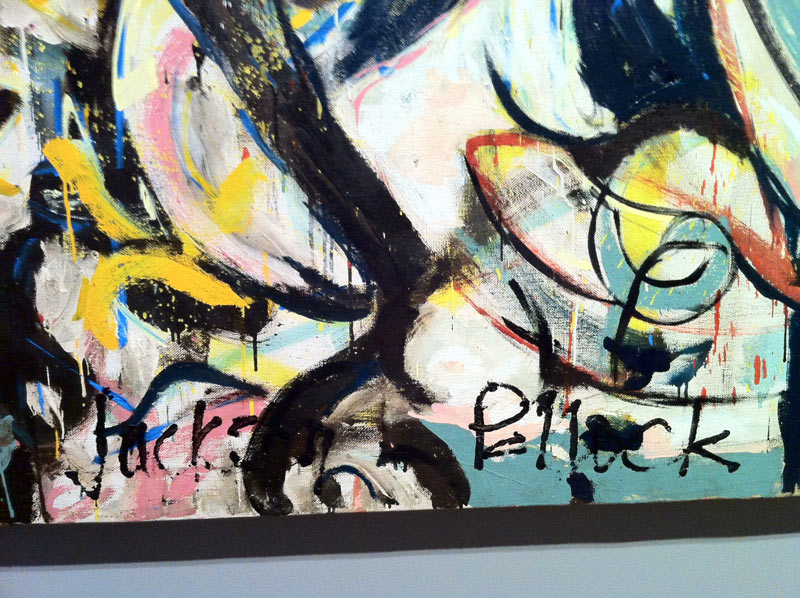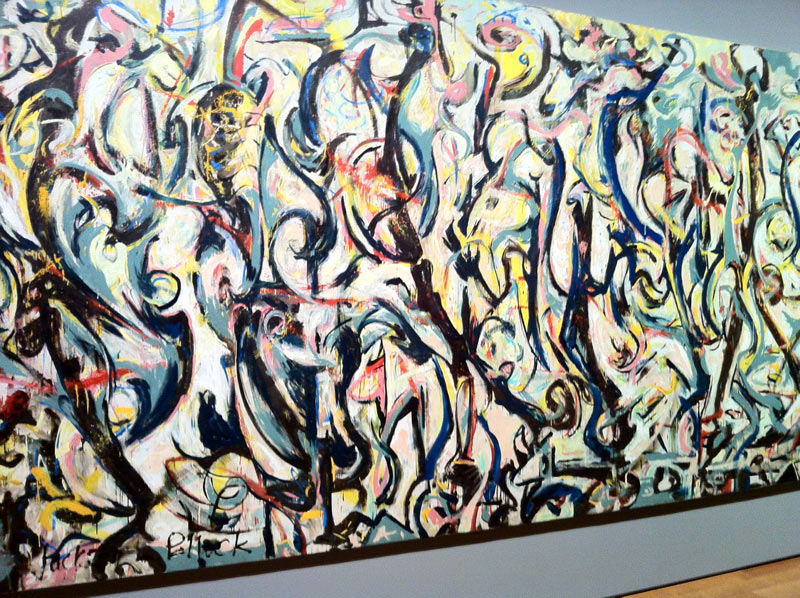Photo by Pauline Adamek
You Take the Highbrow
Pollock at the Getty
BY PAULINE ADAMEK
American Artist Jackson Pollock’s large-scale masterpiece, the abstract impressionist work Mural, has been newly restored and is currently on view at The Getty Center through June 1, 2014.
The legend behind its creation and painstaking restoration imbues this striking painting with a rich backstory.In 1943, Pollock was a promising New York artist who had come to the attention of Peggy Guggenheim (whose father was a casualty of the RMS Titanic). A wealthy socialite and a bohemian, an international jetsetter and art dealer, Guggenheim hobnobbed with the most famous artists of her day. Her art collection and legacy of patronage remain one of the greatest gifts to this country. When the dogma (that the arts should be self-supporting or aren’t worthy of being) rears its serpent’s head, one need only look to the patronage system through the centuries, Lorenzo de’ Medici, Queen Elizabeth I, King Louis XIV and Peggy Guggenheim, who supported the likes of Michaelangelo, Shakespeare, Moliere and Pollock. It was patrons who allowed their art to breathe for subsequent generations.
In July 1943, Guggenheim offered a gallery contract to Pollock, a commission to create a work, roughly eight feet tall by 20 feet long, to be displayed in entry to her new Manhattan townhouse. Though originally commissioned by Guggenheim as a mural, surrealist artist Marcel Duchamp advised Guggenheim to have Pollock paint it on canvas rather than on the wall, in case she eventually moved.
She did relocate to Venice, Italy, shortly after the end of World War II, but the painting remained in the States, enjoying an itinerant and somewhat forgotten life until it found a home at the University of Iowa. It was likely rolled and stored and unrolled at least five times as it moved from Pollock’s studio, to Guggenheim’s entrance hall, to Vogue Studios (for photography), to New York’s Museum of Modern Art, to Yale University, and finally, in 1951, to the University of Iowa Museum of Art, to whom Guggenheim eventually bequeathed it.

Mural predates Pollock’s later iconic style of pouring and splashing paint on a horizontal canvas, known as his “action painting” method. Mural was created the old-fashioned way, with the application of brush to upright canvas. Evidence of Pollock’s emerging style can be seen in his paint flicks, yet the drips run down towards the floor—proof that the canvas was vertical during its execution. Indeed, Pollock removed a wall in his own townhouse in order to create the work, albeit at close quarters.
Guggenheim’s contract was for one year and included the commission of smaller works. Pollock was given very little by way of instruction — simply the princely sum of $150.00 per month for a year in exchange for his promise to deliver and install the first work in time for her annual New Year’s Eve party, approximately six months later.
Many myths swirl around the dramatic artwork, including rumors that Pollock laid its visual foundations in a 36-hour frenzy of inspiration. After Guggenheim moved to Italy, she loaned Mural to the Museum of Modern Art for a large exhibition that included works by Picasso. Displayed in this exciting contemporary company, Pollock’s reputation was cemented.
In July 2012, the painting was transported to the Getty Center for an in-depth study and conservation treatment. The Getty is currently displaying Mural in one room until June 1, 2014. In an adjacent room, there are exhibits detailing the painting’s restoration, including some fascinating sleuth work (seen in a video that charts the analytical experiments) as the Getty’s restoration team strove to understand which paints Pollock may have used. Brimming with vivid swirls and energy, the monumental work represents a transitional moment in Pollock’s career, as he moved toward an experimental application of paints of all types.
Additional information is available at www.getty.edu



